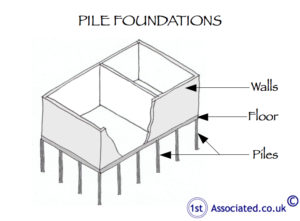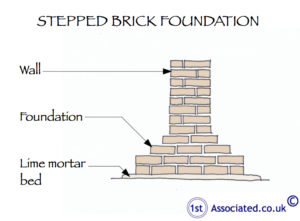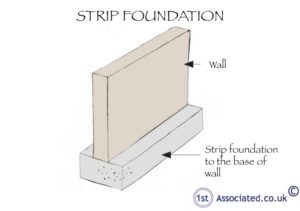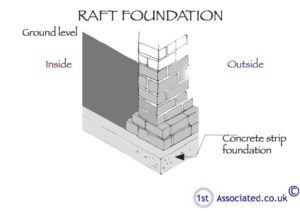Foundations
We can offer a full range of surveys; from residential building surveys when buying a home to live in, to commercial building surveys or schedules of condition if leasing a workplace business, to specific defects reports if you have a problem with your property, for example dampness, cracking, etc, to valuation reports to check you are paying the correct amount for the property you are buying (note these are not for bank lending but are to advise you how much we feel the property is really worth), to dilapidations work when leaving a work place.
Please Free Phone us on 0800 298 5424 and a surveyor will call you back for a friendly chat.
The history of foundations
We will first look at the different types of foundations and then will look at the problems with foundations settling, subsidence and structural cracking to the foundations.

Old foundations
 It could be argued that foundations started with no foundations at all, with properties were literally built off the ground, although, equally, it could be said that the first foundations were wood piled.
It could be argued that foundations started with no foundations at all, with properties were literally built off the ground, although, equally, it could be said that the first foundations were wood piled.
We have actually seen some very old timber pile foundations, when we carried out a renovation project on a Tudor property, which was located near the Broads in Norfolk . The timber foundations were perfectly preserved where they stood below the water table level for many years, only rotting at high level where they went through the wetting and drying process, depending upon the season and also, in this particular case, depending upon whether the nearby road flooded! It certainly proved that timber foundations can last a long time.
Stepped brick foundations, also known as brick flat foundations
 This is where bricks are laid wide of the bottom of the trench, typically 18 inches. They are generally laid loose with no mortar in between the bricks, although they can be laid on a lime cement bed and then stepped in until they become the actual wall, which, we assume, is why they are called stepped brick foundations.
This is where bricks are laid wide of the bottom of the trench, typically 18 inches. They are generally laid loose with no mortar in between the bricks, although they can be laid on a lime cement bed and then stepped in until they become the actual wall, which, we assume, is why they are called stepped brick foundations.
Traditional strip foundations
 It always interests us when the word traditional is used. It should probably, more correctly, be called common strip foundations. These are not very wide and not very deep (compared with modern foundations). These are typically two foot wide by one foot deep and were used around the War years.
It always interests us when the word traditional is used. It should probably, more correctly, be called common strip foundations. These are not very wide and not very deep (compared with modern foundations). These are typically two foot wide by one foot deep and were used around the War years.
Trench filled foundations
These were much deeper, but were still typically two feet to 18 inches (600mm to 450mm) by a metre deep.
Little changed until the summer of 1976
This was the dry, hot summer of 1976, where many properties were affected by settlement, particularly those close to trees, that were hunting out water, and particularly those in clay soil. This resulted in a revision of the depth of foundations to 1.2 metres and this is why if the building control officer sees roots in a foundation when it is dug (the foundations are one of the phases when the building control officer should inspect), they generally tend to ask for the foundations to be made deeper.
Pile foundations
We were discussing when concrete pile foundations were first invented. We feel it must be around the war years.

We would divide the present methods of pile foundation into two areas: board and driven hammered.

Board
The board pipes are cut with an auger. They add to a bedrock and reinforced concrete is added in situe, with sometimes (although we have never seen it) this end being hammered.
Driven hammered
The second type of piling divides into driven, hammered and vibrated. This is literally where the pre-cast concrete is driven into the ground and can cause vibration damage to surrounding properties. A steel casing is used that is driven into the ground, displacing the soil. On to this is added a reinforced concrete ground beam in situe, which is tied into the pile foundation. Traditionally, a timber shuttering is used to form the ground beam, which, although expensive, can be re-used. More recently polyplus plastic has been used to form the shuttering (think estate agents For Sale boards or To Let boards) and although these are not cheaper (about one-tenth of the price) they can't generally be re-used. Of course, the cheapest way of forming the sides to the reinforced concrete ground beam is to use the ground as it is free, apart from the labour involved.
Raft foundations
 This is a reinforced rectangular slab, which is used to spread load, where the load bearing capacities of the ground are not that good. It is also used in basements, but this is more on an economical basis.
This is a reinforced rectangular slab, which is used to spread load, where the load bearing capacities of the ground are not that good. It is also used in basements, but this is more on an economical basis.
Pad foundations
These are used to distribute point loads, where the building has been built on a structural frame, such as a structural steel portal frame, or reinforced concrete columns. They are also used in areas where the ground is relatively poor to spread the load.

Cracking to foundations
As the foundations are underground the cracking simply can't be seen. However, it can be, with a good building survey, identified from other signs. These can range from the relatively obvious sign of cracking in the walls (although it is difficult an art to then establish where the cracks come from), to signs of movement, such as the windows or door frames being out of alignment, or the roof frame having been dislodged, or tiles and slates lifting. There really are too many examples to mention, but a good surveyor would be able to identify these.
Frequently asked questions
We can't see our foundations how can we tell what the problems are with it?
Building surveyors will know and understand what sort of foundation will typically be used in a given type of property construction and in a particular area. Although, it is only when you dig up the foundations that you truly know, as we have found in the past that changes often get made to what is drawn. See our comments in cracking to foundations above. We would add, although it is only when you dig up the foundations that you truly know, as we have found in the past, foundation failure can be because there literally is no foundation there. One example we can give is a boundary wall; substantial brick wall that was literally built off mortar boards; these are the boards that the mortar is mixed up on. So, almost anything could happen on a building site!
Foundations and Underpinning
Structural Cracking
Cracks in my Wall
How, in our experience, Insurance Companies deal with Cracks in Properties
Settlement, Subsidence and Heave and the part clay soils play in this
Please see our section on: Specific Defects Reports
If you truly do want an independent expert opinion from a surveyor with regard to structural surveys, building surveys, structural reports, engineers reports, defects report, including things such as cracks, dampness, condensation, foundation problems, etc, dilapidations, home buyers reports or any other property matters please contact 0800 298 5424 for a surveyor to give you a call back.
If you have a commercial property, be it leasehold or freehold, then you may wish to look at our Dilapidations Website at www.DilapsHelp.com and for Disputes go to our Disputes Help site www.DisputesHelp.com .
We hope you found the article of use and if you have any experiences that you feel should be added to this article that would benefit others, or you feel that some of the information that we have put is wrong then please do not hesitate to contact us (we are only human).
The contents of the website are for general information only and is not intended to be relied upon for specific or general decisions. Appropriate independent professional advice should be paid for before making such a decision.
All rights are reserved the contents of the website are not to be reproduced or transmitted in any form in whole or part without the express written permission of www.1stAssociated.co.uk
